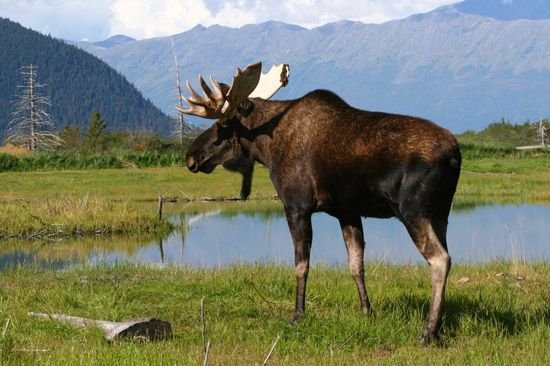The Forget-Me-Not was designated as the state flower in 1917, chosen for its deep-rooted significance to the state’s identity and heritage. This small, delicate flower has come to symbolize not only the natural beauty of Alaska but also the resilience and enduring spirit of its people.
Alaska’s Official State Symbols
Alaska boasts a rich array of state symbols that reflect its unique culture, history, and environment. Key symbols include:
State Bird: Willow Ptarmigan
Willow Ptarmigans are found in tundra regions, willow scrub, and muskeg, typically north of the timberline. They prefer areas with abundant dwarf willow thickets.

State Fish: King Salmon
King salmon are the largest of all Pacific salmon species, with adults typically weighing between 30 to 126 pounds. The largest recorded King salmon weighed 126 pounds, caught in Petersburg, Alaska, in 1949.

State Mammal: Moose
Alaska is home to an estimated 175,000 to 200,000 moose, making it one of the highest densities of moose in North America.

State Tree: Sitka spruce
Sitka spruce can grow up to 100 meters (approximately 330 feet) tall, making it the largest species of spruce and the third-largest tree in the world, after the coastal redwood and Douglas fir.

State Flower: Forget-me-not
The peak blooming period occurs from late June to late July, making it a prominent sight in Alaskan alpine meadows during the summer months.

These symbols collectively represent Alaska’s diverse ecosystems and the cultural heritage of its residents, emphasizing the connection between nature and community life.
How the Forget-Me-Not was chosen ?
As we know, the Forget-Me-Not was chosen as Alaska’s official state flower in 1917, a decision that reflects both the flower’s beauty and its deep cultural significance to the people of Alaska. The selection process involved several factors that contributed to its designation, highlighting the flower’s symbolic power and connection to Alaskan identity.
- Early Recognition: The Forget-Me-Not was recognized in Alaskan culture before its official adoption, appearing in local folklore and stories. Its name evokes sentiments of remembrance and loyalty, resonating with the values of the Alaskan people. Alaska is home to approximately 1,700 species of flowering plants. This includes a wide variety of wildflowers, shrubs, and trees adapted to the state’s unique climate and geography.
- Pioneering Spirit: The flower was initially chosen by the “Grand Igloo,” an organization of pioneers who settled in Alaska before 1900. They included it in their constitution in 1907, which laid the groundwork for its later adoption as the state flower.
- Legislative Action: In 1917, a bill was introduced to declare the Forget-Me-Not as the official floral emblem of Alaska. This occurred 42 years before Alaska achieved statehood, underscoring its importance as a symbol of Alaskan identity even during territorial status.
Forget-Me-Not Flower Significance
- Resilience and Loyalty: Symbolism of Alaska’s state flower is resilience, loyalty, and remembrance—qualities that reflect the spirit of Alaskans who have historically faced and adapted to challenging conditions. Its ability to thrive in Alaska’s harsh climate mirrors the tenacity of its residents.
- Cultural Connection: The flower serves as a link between generations, embodying the pioneering history of Alaska and fostering a sense of community among its people. It represents not only personal connections but also a collective memory of shared experiences and challenges.
- Aesthetic Appeal: With its delicate blue petals, the Forget-Me-Not stands out among other wildflowers in Alaska. Its beauty complements the rugged landscapes of the state, making it an appropriate symbol for a place known for its natural splendor.
Forget-Me-Not Flower as State Flower
The Forget-Me-Not (Myosotis alpestris), designated as the state flower in 1917, carries profound meanings that resonate deeply with the state’s culture and identity. Here are the key aspects and meaning behind forget-me-not:
- Remembrance and Memory: Symbolizes a plea to remember loved ones and preserve cherished memories.
- Loyalty and Fidelity: Represent enduring love and strong bonds that withstand time.
- Resilience and Strength: Thrives in harsh climates, mirroring the determination and adaptability of Alaskans.
- Cultural Significance: Chosen by pioneers as an emblem of their spirit, reflecting local pride and heritage.
- Aesthetic Appeal: Its striking blue petals enhance Alaska’s natural beauty, making it a beloved part of the landscape.
Reasons for the Selection of the Forget-Me-Not as State Flower
| Reasons | Key Points | Visual Element | Statistics |
| 1- Historical Significance | – Designated as the state flower in 1907 |  |
|
| – Designated as the state flower in 1907 | – Adopted as state flower 10 years before statehood (1959) | ||
| – Chosen through a public vote by schoolchildren | – 142 designs submitted for state flag contest (1926) | ||
| 2- Cultural Representation | – Symbolizes resilience and endurance of Alaskans |  |
|
| – Represents love and remembrance, reflecting Alaskan values | – Represents over 100 years of Alaskan culture | ||
| – Frequently used in local art and literature | – Mentioned in over 20 cultural references | ||
| 3- Environmental Adaptability | – Thrives in harsh climates, showcasing strength |  |
|
| – Grows in diverse habitats across the state | – Grows at altitudes of 5,000 to 12,000 feet | ||
| – Represents lasting love and friendship | – Blooms for approximately 4-6 weeks | ||
| – Associated with memorials and remembrance events |
How Did The Forget-Me-Not Become A Part Of Alaska’s State Flag?

The Forget-Me-Not became a part of Alaska’s state flag through the design choices made by Benny Benson, a young student who won a contest to create the flag in 1927. The flag features a dark blue field, which symbolizes both the sky and the Forget-Me-Not flower. This connection was intentional, as Benson wanted to represent Alaska’s natural beauty and cultural identity.
Key Points of Connection
-
- Design Inspiration: Benny Benson’s design included the blue background specifically to reflect the color of the Forget-Me-Not, linking the flower directly to the state’s identity. The blue field serves as a backdrop for eight gold stars that form the Big Dipper and Polaris, symbolizing guidance and strength.
-
- Symbolic Significance: The inclusion of the Forget-Me-Not in the flag emphasizes themes of remembrance and loyalty, qualities that resonate deeply with Alaskans. The territorial flower of Alaska reflects not only the natural environment but also the enduring spirit of the state’s residents.
-
- Legislative Recognition: Following its adoption in 1927, the symbolism of the Forget-Me-Not was further solidified when it was designated as Alaska’s official state flower in 1917, well before statehood. This early recognition showcased its importance to Alaskan culture and heritage.
FAQ
The Forget-Me-Not was chosen as Alaska’s state flower for its symbolism of remembrance and loyalty, reflecting the strong community ties of Alaskans. Its resilience in harsh climates and historical significance to pioneers further underscore its importance in Alaskan culture
The Forget-Me-Not was officially chosen as the state flower on April 28, 1917. This designation occurred before Alaska became a state in 1959, reflecting the flower’s significance in Alaskan culture and its connection to the state’s identity.










